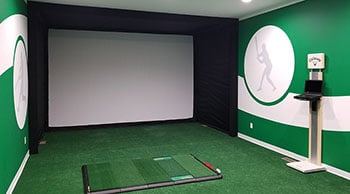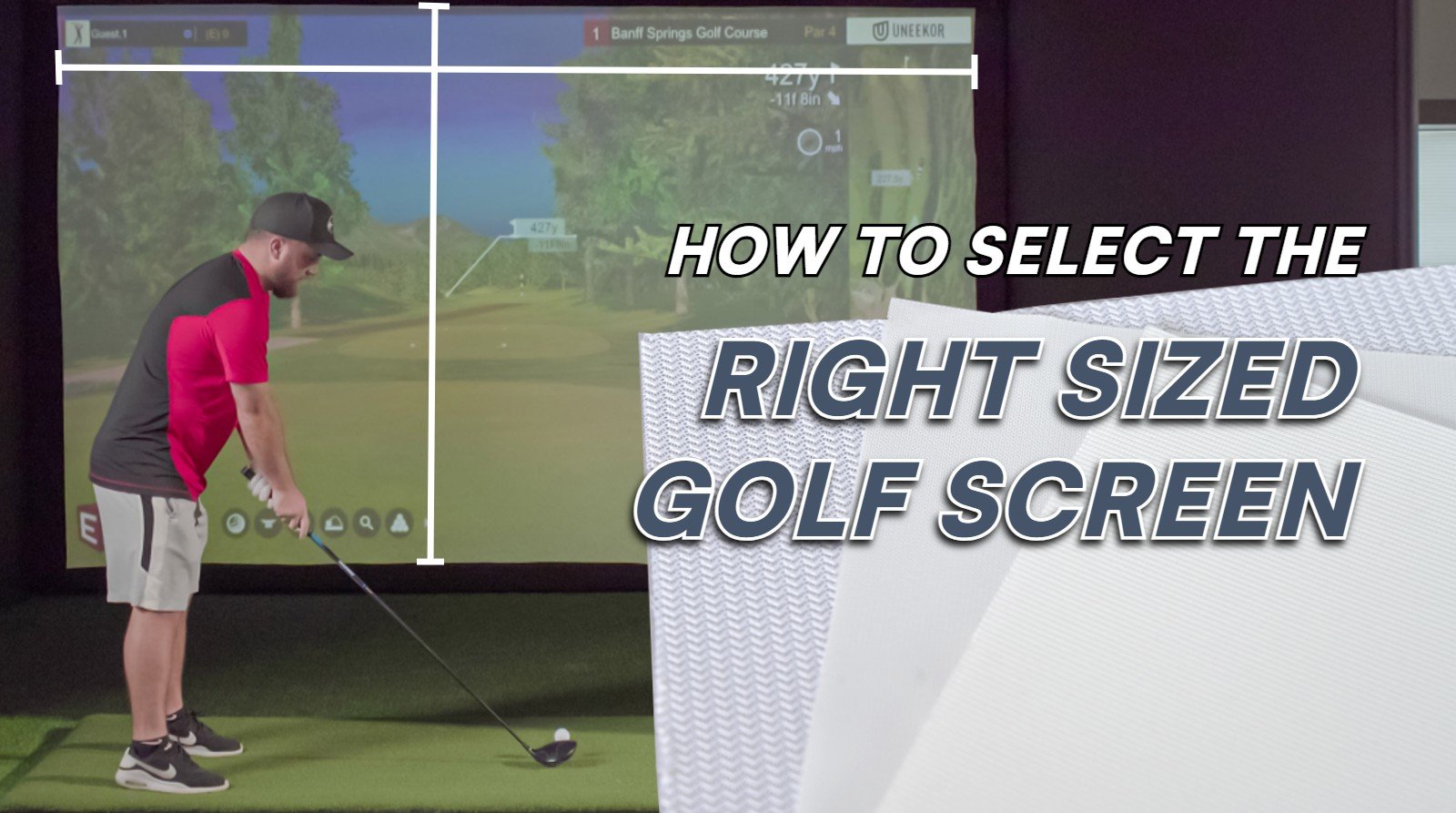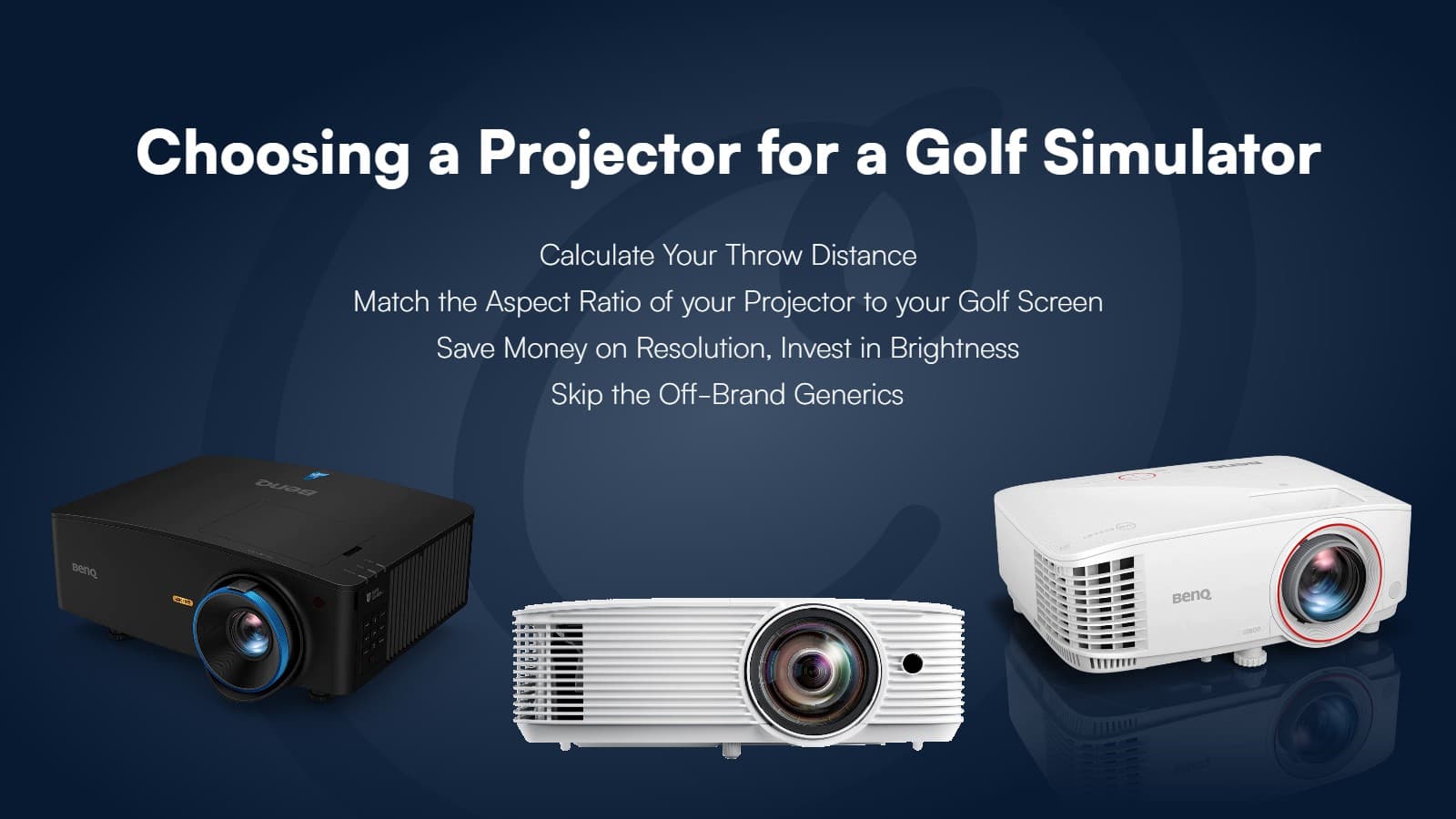Worried about missing the enclosure with your shots? Size your golf simulator to be as tall and deep as possible to manage high golf ball flight trajectories.
 “Am I safe to hit wedge shots on a 5-foot deep golf simulator enclosure? Is it possible for me, someone … anyone … to hit a wedge shot high enough to miss my enclosure?”
“Am I safe to hit wedge shots on a 5-foot deep golf simulator enclosure? Is it possible for me, someone … anyone … to hit a wedge shot high enough to miss my enclosure?”
We get asked these questions about golf ball trajectory in a golf simulator often. Maybe you’re trying to learn how to hit a low golf shot because your launch angle and ball flight are higher than most players. As you’re learning, you’re still likely to hit your high-lofted shots every once in a while. Or, maybe you’re going the other way and actually trying to hit a higher wedge shot to help your ball land softer on the green.
No matter what the situation, many different factors contribute to the answers for these questions. There are three main ways to mitigate your worry of missing the enclosure with higher lofted clubs.
How To Protect Against High Trajectory Golf Balls in a Golf Simulator
-
If space allows, go for a taller enclosure. Depending on your height and accuracy, an enclosure that is 9 feet tall or taller tends to keep more golf balls in the simulator area.
-
If space allows, look into an enclosure deeper than 5 feet. Making your enclosure deeper helps with ricochets or those sideways shanks.
-
If space only allows enclosures with short heights or shallow depths, add your own custom protection above and around your enclosure. {anchor link}
Don’t know what your space allows for? Here’s how to measure your space for a golf simulator.
Golf Ball Trajectory Chart
With the help of Trackman’s PGA Tour launch angle averages, plus some of our own research, we were able to gather some useful data. Per Trackman, here are the average launch angles for each club when a PGA Tour player hits them.
|
Club
|
Launch Angle
|
|
Driver
|
10.9°
|
|
3-wood
|
9.2°
|
|
5-wood
|
9.4°
|
|
Hybrid (15-18°)
|
10.2°
|
|
3 Iron
|
10.4°
|
|
4 Iron
|
11°
|
|
5 Iron
|
12.1°
|
|
6 Iron
|
14.1°
|
|
7 Iron
|
16.3°
|
|
8 Iron
|
18.1°
|
|
9 Iron
|
20.4°
|
|
Pitching Wedge
|
24.2°
|
Based on these averages, even the highest lofted club included in the data - the pitching wedge - is nowhere near going over the enclosure when hitting from our suggested 10-12 feet away from the impact screen. Even if someone with these averages were to hit an accidental extra floppy wedge shot, the ball would likely still be contained inside any standard 5-foot deep enclosure we sell at Carl’s Place.
Check out the animation below for a visual of how the PGA Tour player launch angle averages look in a real-life golf simulator setup.
However, not all golfers are the same, especially when comparing amateurs to top-tier professions. Many amateurs have a higher ball flight because they tend to scoop the ball off the hitting surface instead of striking it. We didn’t really want to call anybody out, but our content writer Mike (yeah, that’s me) is known to be one of these players.
So I decided to test out hitting some wedges on our shortest DIY Enclosure (7.7’ tall) with the standard 5-foot depth. I was hitting an approach/gap wedge from about 11-12’ away from the impact screen. Check out the gif below to see how the short enclosure was just barely catching the ball.
.gif?width=480&height=270&name=giphy%20(4).gif)
To gather more “amateur” data, we had several Carl’s Place employees hit 25 gap wedge shots to see what their average launch angles came out to. Some important factors to keep in mind: some gap wedges are made with slightly different loft angles, and the way balls are made can affect launch angle as well. We were using the old Bridgestone Marked Balls for Uneekor QED.
| |
Player 1
Transformed baseball player, golfs the most but time is dwindling with growing family
|
Player 2
Huge hockey guy who has been improving the past few years
|
Player 3
Since starting at Carl’s Place a year ago, he’s been trying to golf more. Working on consistency
|
Player 4
Longtime golfer, getting back into the swing of things after a back surgery
|
|
Gap Wedge Launch Angle
Average
|
43.9° (max 49.2°)
|
35.8° (max 40°)
|
29° (max 41.1°)
|
38.7° (max 40.6°)
|
After doing this research and testing, I knew I could not hit my sand or 60° wedge because it most certainly would have missed the enclosure.
Note: If it weren’t for the projector placement in the hitting bay I was using, I could have moved my tee location up to 10 feet from 11-12 feet, which might have helped keep my shots contained inside the enclosure. Often times, the projector or launch monitor in your setup won’t allow for you to significantly move your tee location, but if it does, keep that in mind as a way to help mitigate these concerns.
So, for players like me who are continually asking, “Why is my ball flight so high?” … How do we alleviate those concerns so you don’t send a ball through your ceiling and into your attic or child’s bedroom?
Managing Golf Ball Trajectory in a Golf Simulator
OPT FOR A TALLER ENCLOSURE
The use of high-lofted clubs is one of the main reasons we recommend getting the largest (tallest and widest) enclosure that will fit in your space. The larger the enclosure, the better the chance that it will contain more shots, both above and to the sides of the hitting area.
Carl’s Place Golf Simulator Enclosure Kits come in several standard sizes to fit your space. Again, you want to go as tall as your space allows to contain those high trajectory golf balls.
However, maximizing your enclosure in your space might create an odd aspect ratio for your projector to try to match.
For example: say your space is 10 feet tall, by 9 feet wide. Carl’s Place can custom make an enclosure to those specs, but that would be a 9:10 aspect ratio. The most common aspect ratios for golf simulators are 4:3 and 16:9 or 16:10 to match the most common aspect ratios of projected images.
So, 9/10 = 0.9, while 4/3 = 1.33 and 16/9 = 1.78. With 0.9 not being close to 1.33 or 1.78, that means you will either have unused space on your impact screen by the projected image, or the projected image will spill over the sides of the viewable screen. Here’s more on aspect ratio and how to choose the best enclosure size.
CUSTOMIZE YOUR GOLF ENCLOSURE HEIGHT
If you’d like your projected image to fill the viewable screen area fully for that picture-perfect look, then use our Build Your Own Golf Simulator Tool. In the section where you choose your screen size, you will be able to choose your aspect ratio, input your room size in inches and see what maximum screen and enclosure dimensions will work with those constraints in your space.
A lot of times, home golf simulators are 4:3 aspect ratio because that allows the enclosure to go taller. A 16:9 or 16:10 aspect ratio impact screen and enclosure is significantly wider than it is tall, which means you’re going to hit your width limit much quicker than a 4:3 setup, and the quicker you hit your width limit, the shorter your enclosure is going to be.

CHOOSE A DEEPER ENCLOSURE
Carl’s Place DIY enclosures are designed to fit small spaces with their standard 5-foot depth. However, you can get a deeper enclosure with the Carl’s Place Pro Golf Enclosure Kit. An enclosure that comes farther out toward the hitting area would help catch any high-launched shots.
Note: While DIY Enclosures max out at 5-feet deep, Carl’s Pro Enclosure maxes out at a whopping 20 feet deep.
Now, we don’t have to get too crazy and go 20 feet deep … although playing fully inside an enclosure is quite the immersive experience. Even just going out to an 8-foot deep enclosure gives you that extra 3 feet of coverage, which would have been plenty to contain my highly launched wedge shots.
Keep in mind that the deeper your enclosure, the closer it encroaches into your hitting area, so the better chance it then becomes a thought or factor in your swing follow through. To alleviate this, you would want to make sure your Pro Enclosure is tall and wide enough to be out of the way of any swinging clubs.
An ideal setup would be to have a tall, wide and deep enough enclosure so that the golfer is fully surrounded by enclosure walls and does not have to worry about spraying balls everywhere. If space and budget allow, it’s definitely a worthwhile investment.

ADD YOUR OWN CUSTOM PROTECTION
If your space only allows you to have a shorter enclosure depth or height that makes you feel uncomfortable about hitting wedge shots, then you’ll seriously want to think about adding your own custom protection around your enclosure. If there is any hesitation, it could affect the way you swing the club and change your game, and we don’t want you worrying about that.
Some options might be: foam padding that is attached to the walls/ceiling for a more built-in look, nets that attach from the top pipe of the enclosure frame to the ceiling above the hitting area (think net wall extensions but for above), a horizontally hung curtain/net that drapes down in waves across the ceiling to help knock the ball down, and so on.
Let us know in the comments below if you’ve done anything like this to protect your surrounding area. After all, there are many different options - some will look more clean and finished than others, but that doesn’t mean they are any more effective.
CONCLUSION
While you’re looking at how to control golf ball trajectory, if the thought of a wedge shot missing an enclosure has ever crossed your mind, we highly suggest alleviating that concern one way or another. Golf can be an extremely mental game and if you have extra thoughts in your mind, especially ones involving a potentially dangerous situation, it likely will affect your swing and overall game.
Be sure to make your space safe - select a golf simulator enclosure that is tailored to your space; one that is tall and deep enough to trap those soaring golf balls.




 “Am I safe to hit wedge shots on a 5-foot deep golf simulator enclosure? Is it possible for me, someone … anyone … to hit a wedge shot high enough to miss my enclosure?”
“Am I safe to hit wedge shots on a 5-foot deep golf simulator enclosure? Is it possible for me, someone … anyone … to hit a wedge shot high enough to miss my enclosure?”.gif?width=480&height=270&name=giphy%20(4).gif)
